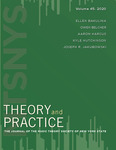Triadic Transformation and Parsimonious Voice Leading in Some Interesting Passages by Gavin Bryars
Author: Roeder, John Publication details: Intégral 20:43-67 Weblink: https://www.jstor.org
Autonomy and Dialog in Elliott Carter’s ‘Enchanted Preludes
Author: Roeder, John Publication details: Analytical Studies in World Music. Ed. Michael Tenzer. New York: Oxford. Weblink: http://www.oxfordscholarship.com Abstract: This chapter provides a detailed examination of a contemporary chamber work by a celebrated American composer, with: Social and Artistic Context; One Composer’s Response; Sources of Autonomy: Definitions; Textural Overview; Pitch-Interval Dialogue; Deepening Engagements; and Closure.
Co-operating Continuities in the Music of Thomas Adès
Author: Roeder, John Publication details: Music Analysis 25/1-2: 125-154 Weblink: http://onlinelibrary.wiley.com Abstract: Jonathan Kramer defined postmodern music as an ironic, fragmentary mix of past and present compositional procedures embodying multiple temporal dimensions. Recent theorising grounded in phenomenological and cognitive-scientific accounts of musical experience suggests that it may be possible to develop a more insightful interpretative perspective by extending Kramer’s […]
La conservazione a lungo termine dell’autenticitá di composizioni digitali interattive: la ricerce di InterPARES 2
Author: Roeder, John and Duranti, Luciana Publication details: Archivi e Computer 15/3: 45-62 Weblink: http://www.interpares.org
Time Management with ‘Twelve-Tone Lizzie’: Dramatic Functions of Meter in a Scene from Elisabeth Lutyens’s Music Drama The Numbered
Author: Laurel Parsons Publication details: Time Management with “Twelve-Tone Lizzie”: Dramatic Functions of Meter in a Scene from Elisabeth Lutyens’s Music Drama “The Numbered”, Theory and Practice 30 (2005): 153–83. Music Theory Society of New York State Weblink: www.jstor.org
Rhythmic Process and Form in Bartók’s ‘Syncopation’
Author: Roeder, John Publication details: College Music Symposium, Vol. 44 (2004), pp. 43-57 Weblink: http://www.jstor.org
Preserving authentic interactive digital artworks: case studies from the InterPARES project
Author: Roeder, John Publication details: International Cultural Heritage Informatics Meeting: Proceedings from ichim04 (Berlin). CD-ROM. Toronto: Archives & Museum Informatics. Weblink: http://www.interpares.org
The Craft of Hybrid Composition: Meter, Tonality, and Grouping in Michael Torke’s ‘Adjustable Wrench’
Author: Roeder, John Publication details: Perspectives of New Music 41/2: 120-158. Weblink: https://www.jstor.org
Beat-Class Modulation in Steve Reich’s Music
Author: Roeder, John Publication details: Music Theory Spectrum 25/2: 275 – 304 Weblink: http://www.jstor.org Abstract: A beat-class model of rhythm, employed by Cohn and others to analyze textural form in Steve Reich’s early phase-shifting compositions, is here enlarged to embrace the concepts of beat-class “tonic” and “mode,” defined formally by analogy to pitch-class tonality. Using these concepts, analyses […]
Pulse Streams and Problems of Grouping and Metrical Dissonance in Bartók’s “With Drums and Pipes”
Author: Roeder, John Publication details: Music Theory Online 7, no. 1 (2001) Weblink: http://mtosmt.org Abstract: Polyphony has many interesting rhythmic properties that do not obtain in textures that are modeled by most rhythmic theories. This paper invokes the concept of pulse streams to demonstrate how phenomenal accent and grouping are organized in a extended two-voice polyphony by Bartók […]
